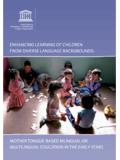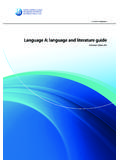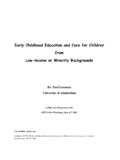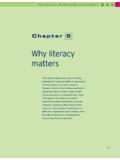Transcription of Academic success for non-native English speakers in ...
1 1 NOTE: This article was originally published in NALDIC Quarterly Autumn 2009 ---------------------------------------- ---------------------------------------- ---------------------- Academic success for non-native English speakers in English -medium international schools: The role of the Secondary ESL department Paul Shoebottom, Frankfurt International School. Abstract: This paper outlines the various responsibilities of the ESL department in an English -medium international school. These responsibilities include not only day-to-day ESL instruction, but also close collaboration with administrators, mainstream teachers and parents, so that each party is fully aware of its own special role in ensuring the Academic success of students with English as an additional language. ---------------------------------------- ---------------------------------------- ------------------- A typical English -medium international school contains a significant proportion of students who are learning English as an additional language.
2 Indeed, it is common for the majority of students at an international school to have a mother tongue other than English1. These non-native students have a daunting task. They must learn new content and skills in a language over which they are still gaining mastery. Almost all of their classes will be in English , and they will take the same internal and external exams in English as their native-speaking peers. An international school that enrols English language learners (ELLs), usually for high tuition fees, has the clear responsibility to do all it can to maximize the chances of these students achieving Academic success and thereby gain access to the further education of their choice. There are some international schools, as Carder (2007) notes, where there is no special provision for students with limited English .
3 They are placed in the full mainstream on the assumption that they will soon pick up English and be able to participate in lessons. This may be true for some students, particularly in respect of their basic interpersonal communication skills (BICS see Cummins, 1984). Most international schools, however, acknowledge that the development of the students' cognitive Academic language ability (CALP Cummins, 1984) is the key to Academic success , and that this needs much more focused effort and attention. It will not develop quickly or effectively enough in what Carder (2007) calls the "sink or swim" of the full mainstream. 1 The EL Gazette (2005) states: 'The majority of students in international schools are non-native speakers of English .
4 In the 2004 European Council of International Schools (ECIS) annual statistical survey, 297 schools with a total enrolment of 161,86376 students indicated that over half the student population (59%) spoke English as an additional language (EAL). Of these, 198 schools (67%) had 50% or more such students while only 21 schools had fewer than 10% EAL speakers . In 18 schools none of the students spoke English as first language' (quoted in Carder, 2007). 2A large number of international schools, therefore, employ ESL specialists with the responsibility of supporting students of limited English proficiency. The Academic success of such students can best be ensured if the ESL teachers have a clear concept of their crucial role, not only in working directly with English language learners, but also in assisting mainstream teachers and school administrators in fulfilling their duty to create a school with optimal learning conditions.
5 The ESL department also has a special role in educating parents of non-native English students in what they can do to optimize their children's chances of success . While the responsibilities of the ESL department go beyond the provision of direct support to ESL students2, this remains its primary duty. The nature and content of such support should be guided by current research3, and take into account the special circumstances of the school, its curriculum and its student body. As Genesee (1999) states: "No single approach or programme model works best in every situation. Many different approaches can be successful when implemented well. Local conditions, choices, and innovation are critical ingredients of success ." Collier, whose extensive research with Thomas (2002) provides clear evidence of the superiority of the two-way bilingual model4 for situations where there are large numbers of non-native - English students with the same mother tongue, states that "ESL instruction may be the best way to support non-native English students in international schools" (in Murphy, 2003).
6 A number of international schools, indeed, have decided that a temporary, partial withdrawal of ESL students from the mainstream to receive direct language instruction and mainstream subject support is the best way of meeting these students' immediate and longer-term needs. Since the overriding objective is that ESL students achieve Academic success , it follows that the focus in ESL lessons must be on doing work that helps students learn Academic language and Academic language skills. A traditional EFL syllabus that has as its primary goal the development of communicative competence will be inappropriate (Krashen, 2003). Many ESL departments have implemented a content-based syllabus that combines the acquisition of useful factual knowledge with the development of Academic language and skills such as note-taking based on authentic text, expository writing or making oral presentations.
7 Some ESL instructional time will need to be devoted to preparing ESL students for forthcoming assignments in their mainstream classes or helping them revise work before it is handed in. (See the Appendix A for a brief description of the content-based ESL instructional programme at Frankfurt International School.) A well-constructed, pedagogically-sound ESL programme can positively influence the rate at which the ESL student closes the gap on his or her native-speaking peers. However, the role of the ESL department in an international school goes further than simply designing and implementing ESL instruction. The time that students spend in ESL 2 An ESL student is a student whose English is sufficiently limited for him or her to be considered in need of ESL instruction.
8 Thus, not all non-native speakers are ESL students. 3 Hinkel (2003) notes, for example, The teaching of perfect progressive verb forms and their uses may not be worth the time in L2 Academic writing instruction . 4 A typical two-way bilingual class in an American public school consists of approximately equal numbers of English and Spanish students. They have some of their lessons in English and the other lessons in Spanish. 3lessons is generally much less than the time they spend in their mainstream classes. If the students are quickly to become peer-competitive, able to fully participate in classroom activities and gain good grades in homework assignments and tests, it is essential that this time is spent as productively as possible. The second responsibility of the ESL department, therefore, is to ensure that mainstream teachers have the knowledge and skills to get the best out the non-native English speakers in their classes.
9 Optimal mainstream subject instruction occurs when the teacher is able to modulate classroom language and adapt classroom work so that the ESL student is able to participate in the tasks and achieve the learning objectives of the lesson. The ability to do this presupposes familiarity with the facilitators of second language acquisition, particularly in respect of making language comprehensible. It is the responsibility of the ESL specialists, as linguistic experts, to assist their mainstream colleagues in the acquiring the necessary knowledge and skills in this area. One way of imparting theoretical and practical information to mainstream teachers on how to make their instruction "ESL-friendly" is via a reputable commercial in-service programme such as ESL in the Mainstream (DECS, 2008)5 or Enriching Content Classes for Secondary ESOL Students (Jameson, 1998).
10 The courses are designed to be delivered by ESL teachers in the school and take up 50-60 hours of a mainstream teacher s time. Both focus very heavily on how to make language and tasks comprehensible to ESL students following the theories of Krashen (1982) and Vygotsky (1978) - see Appendix B. The clear message is that teachers in a school with a significant proportion of non-native speakers need to consider themselves not only as teachers of mathematics, science or art, but also as teachers of language. An alternative to off-the-shelf courses such as ESL in the Mainstream is for the ESL department to create its own in-service programme, as has been done at Frankfurt International School (Shoebottom, 2007a). This has the advantage of being directly applicable to the particular situation of the school and its student body.






